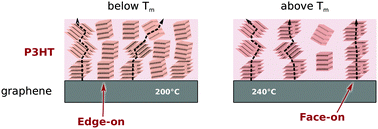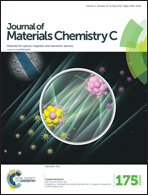Reduced crystallinity and enhanced charge transport by melt annealing of an organic semiconductor on single layer graphene†
Abstract
We report on the effect of the annealing temperature on the crystallization and the electrical properties of the semiconducting polymer poly(3-hexylthiophene) (P3HT) on single layer graphene. Electrical characterization showed that heating the P3HT film above the melting point (Tm) resulted in a higher vertical charge carrier mobility. Grazing incidence X-ray diffraction (GIXD) revealed that the film was actually less crystalline overall, but that it consisted of a much higher number of face-on crystallites. We moreover show that annealing above Tm removes the existing seeds still present in the film at lower temperatures and enhances face-on formation. These results provide a better understanding of the influence of the annealing temperature on polythiophene crystallization on graphene, and it shows that the annealing at higher temperature induces a more favorable crystalline orientation which enhances charge transport, despite the reduction in the overall crystallinity. These results should help in the design of more efficient graphene based organic electronic devices by controlling the crystalline morphology of the semiconducting film.


 Please wait while we load your content...
Please wait while we load your content...